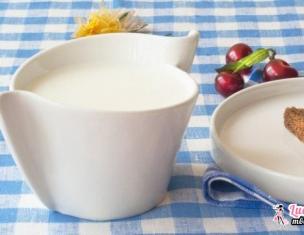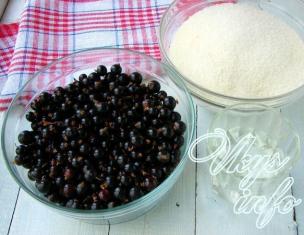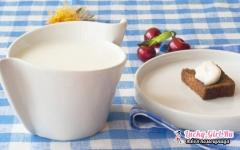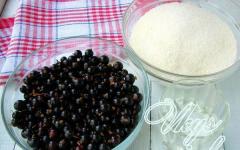People have been drinking drinks made from the milk of cows, goats and sheep since ancient times. A special place is given to fermented milk products in the Caucasus. It is not known whether their love for fermented milk products affects their life expectancy or not, but the fact remains a fact.
Matsoni is a traditional Caucasian fermented milk product, which is called the “nectar of long-livers.” In Armenian cuisine, matsoni is called matsun.
Matsoni tastes like yogurt, but there are some differences between these two products. Yogurt is ordinary sour milk, and matsoni is a more complex fermented milk product that requires a certain technique.
Matsoni at home: benefits
- Matsoni is a very healthy drink that residents of the Caucasus enjoy preparing and drinking. This fermented milk product is easily absorbed by the body, supplying it with phosphorus, calcium, vitamins A and D, as well as essential amino acids and protein.
- Matsoni, like all fermented milk products, stimulates the intestines, enriching it with beneficial vitamins and bifidobacteria.
- Matsoni is an indispensable product that reduces cholesterol levels, it prevents the development of dysbacteriosis, early aging of the body and lowers blood pressure.
The secret of making matsoni at home
Matsoni is obtained from milk fermented at a certain temperature. The basis for matsoni can be not only cow’s milk, but also goat’s or sheep’s. The milk is heated to a temperature of 90 degrees, then cooled to 50 degrees and the starter is added.
Sourdough for matsoni is a mixture of Bulgarian bacillus (a special type of lactic bacterium discovered in Bulgaria) and fermented milk streptococci. The resulting mixture of hot milk and starter is placed in a dark place and the product is not disturbed for 4 hours. During this time, the milk will sour and thicken, and the resulting product will cool. That's the whole secret of making matsoni.
Matsoni is a product for everyone, which differs from kefir and yogurt in its slightly sour and spicy taste. Matsoni is somewhat similar to sour drinking yoghurt, which is due to the Bulgarian stick, which is used to make yoghurts.
Homemade matsoni
Matsoni can be prepared at home, following the sequence of steps and the cooking process.

- Bring the milk (any kind) to the boiling stage (about 90 - 95 degrees), but do not boil - this is very important!
- Cool the milk to a temperature of 40 - 50 degrees.
- Add starter to hot milk. For real Georgian matsoni, matsoni itself is used for fermentation. If you don’t have it, you can take full-fat kefir or sour cream - 1 tbsp for 0.5 liters of milk. sour cream or kefir.
- Stir the prepared mixture, cover with gauze and place in a dark place for 4 hours. It is better if you first wrap the container with the mixture in a blanket or pour the matsoni mixture into a thermos. Do not shake or disturb the matsoni mixture.
- Important - strictly observe the fermentation time: if you reduce it, the matsoni will turn out too liquid, and if you increase it, the matsoni will turn out too sour.
- Then put the matsoni in the refrigerator for 8 hours.
- The next time you prepare matsoni at home, use previously prepared matsoni for the starter.
You can prepare different dishes from matsoni, each time surprising your guests with unusual recipes based on matsoni at home.
Vegetable salad with matsoni at home

Compound:
- Chicken fillet - 300 g
- Carrots - 1 pc.
- Potatoes - 2 pcs.
- Cucumber - 1 pc.
- Greenery
- Matsoni - for dressing
- Salt - to taste
Preparation:
- Boil chicken fillet, potatoes and carrots.
- Cut the boiled ingredients into small cubes.
- Cut the cucumber into strips, chop the greens.
- Place all the ingredients in a salad bowl, add salt and matsoni. Mix everything.
Matsoni salad is ready! It can be used by girls on a diet.
Homemade matsoni soup

Compound:
- Milk - 1 l
- Matsoni - 1 l
- Onions - 6 pcs.
- Butter - to taste
- Egg yolk - 3 pcs.
- Dill, cilantro, tarragon leaves - to taste
- Sea salt - to taste
Preparation:
- Finely chop the onion and fry it in butter until transparent.
- Mix matsoni with milk and shake well.
- Pour the matsoni and milk into a large saucepan, add the onion. Bring the onion and matsoni to a boil, stirring constantly. When the mixture comes to a boil, continue cooking for another 7 minutes.
- Remove the soup from the heat, cool it a little, pour the egg yolks into the soup. Add chopped herbs.
Matsoni soup at home is ready!
Homemade matsoni sauce

Compound:
- Matsoni - 400 g
- Goat cheese - 100 g
- Naduga cheese - 100 g
- Greens (onion, cilantro, dill) - 50 g
- Salt - to taste
Preparation:
- Grate the goat cheese on a fine grater.
- Rub naduga cheese through a sieve.
- Finely chop the greens.
- Pour all the ingredients into a bowl, add salt and matsoni.
- Mix all ingredients thoroughly until smooth.
Matsoni is a very healthy Georgian drink that gives people strength and vigor. Drink matsoni and you will live happily ever after!
Step 1: prepare the milk.
First, pour whole pasteurized or fresh cow's milk into a small saucepan, place it over high heat and heat until 90–95 degrees Celsius. Important: we do not boil this product and periodically check the temperature with a special kitchen thermometer! As soon as the snow-white liquid heats up, use a towel to remove the saucepan from the stove, place it on the countertop and cool its contents until 45–50 degrees.Step 2: prepare matsoni.

When the milk has cooled to the desired temperature, add a couple of tablespoons of matsoni starter; if this is not available, then use full-fat kefir or sour cream. Gently mix everything to a homogeneous consistency, pour it into a sterilized liter or two-liter jar, cover it with a piece of sterile gauze, having previously folded the fabric in 2-3 layers, and set it to ferment in a dark, warm place on 4 hours. If you are preparing a drink in winter, infuse it near a warm radiator, and if in summer, on a glazed balcony, and the mixture should not be shaken or stirred.

We will observe the fermentation time strictly according to the rules; if you reduce it, the matsoni will turn out too liquid, and if you overdo it, it will become cloyingly sour. That's why after 4 hours close the jar with a clean plastic or metal tight-fitting lid, put it in the refrigerator for 8 ocloc'k and only after this can a sample be taken from the drink.
Step 3: serve matsoni at home.

At home, matsoni is served chilled as a drink or used in the preparation of many dishes, for example, as a base for sauces, pastries, jellies, puff desserts, and casseroles. This sour milk product is also used to marinate meat, poultry, stew lamb, veal, pork, beef, chicken or duck, and to dress salads. This drink is very healthy, quenches thirst in summer and strengthens the immune system in winter. Enjoy!
Bon appetit!
To ferment the next portion of the drink, you can use previously prepared matsoni;
Sometimes a mixture of milk and leaven (kefir, sour cream) is left to sit warm all night;
Matsoni is stored in the refrigerator for no more than 5–7 days, after which you need to prepare the next portion of the drink.
Matsoni- a fermented milk drink that was invented in the Caucasus (see photo). Another name is also known - matsun. This drink is fermented milk. The composition of the matsoni starter is very similar to yogurt, but at the same time this drink has a slightly sharp taste and slight gas formation.
The matsoni recipe has been known for a huge amount of time, but it was kept secret for quite a long time, as it was equated to the elixir of youth. Today, to prepare this drink, you can use any milk, which is first heated to 90 degrees, and then cooled to 50. After this, starter is introduced into it. After this, the drink should infuse for 4 hours in a warm place to become thick. True matsoni healers claim that the most delicious and authentic drink is obtained from the milk of Abkhazian cows.
How to store?
The duration of storage of matsoni depends on the amount of whey in the drink, so the less it is, the longer the shelf life. A product prepared in compliance with all the rules will remain fresh for several months.
Beneficial features
 The benefits of matsoni have been known for a huge amount of time. In ancient times, this drink was considered healing. First of all, it will be appreciated by people who are actively involved in sports, since matsoni perfectly quenches hunger and thirst, and it also has an anabolic effect and promotes the formation of muscle tissue. This drink has a calming effect and helps cope with stress and get rid of insomnia. In addition, matsoni helps remove “bad” cholesterol and toxins from the body. All this allows you to use this fermented milk product while losing weight. In addition, it is worth mentioning the low calorie content of this drink.
The benefits of matsoni have been known for a huge amount of time. In ancient times, this drink was considered healing. First of all, it will be appreciated by people who are actively involved in sports, since matsoni perfectly quenches hunger and thirst, and it also has an anabolic effect and promotes the formation of muscle tissue. This drink has a calming effect and helps cope with stress and get rid of insomnia. In addition, matsoni helps remove “bad” cholesterol and toxins from the body. All this allows you to use this fermented milk product while losing weight. In addition, it is worth mentioning the low calorie content of this drink.
This product contains beneficial microorganisms that perfectly fight harmful intestinal microflora. In addition, sourdough has the ability to increase blood circulation and improve the functioning of the kidneys, liver and intestines. It is also worth saying that matsoni is an excellent pain reliever and healing agent for burns.
This product contains beta-carotene, which is essential for vision. This drink also contains phosphorus and calcium, which strengthens bone tissue. Matsoni also contains potassium, which has a beneficial effect on the activity of the cardiovascular system. Thanks to the presence of sodium, the activity of the nervous system improves.
Use in cooking
 Given its unusual taste, matsoni can act as an independent product or as an additive to a huge number of dishes. For example, it can be used in the recipe for first courses and various sauces. In addition, matsoni can be used for baking vegetables and meat.
Given its unusual taste, matsoni can act as an independent product or as an additive to a huge number of dishes. For example, it can be used in the recipe for first courses and various sauces. In addition, matsoni can be used for baking vegetables and meat.
This drink is included in the dough recipe for popular khachapuri. It can also be used instead of sour cream, for example, in okroshka. You can put herbs, spices and garlic in matsoni, which will result in an excellent spread for sandwiches.
How to cook matsoni at home?
 There are many different options for making this drink at home, here is one of them. Take 1 liter of milk and 280 g of natural yogurt without additives. To begin with, the milk is heated to 50 degrees, and then cooled to 40. Then it is mixed with yogurt, covered with a lid, wrapped in a warm blanket and left for 7 hours. After the time has elapsed, the matsoni is ready for use.
There are many different options for making this drink at home, here is one of them. Take 1 liter of milk and 280 g of natural yogurt without additives. To begin with, the milk is heated to 50 degrees, and then cooled to 40. Then it is mixed with yogurt, covered with a lid, wrapped in a warm blanket and left for 7 hours. After the time has elapsed, the matsoni is ready for use.
Harm of matsoni and contraindications
Matsoni can be harmful to people with individual intolerance to the product. You should not abuse this drink if you have problems with the intestines and stomach. Before consuming matsoni, it is recommended to consult a doctor for people with gastritis, pancreatitis, ulcers and hepatitis.
Matsoni is a traditional drink of the peoples of the Caucasus, Georgia and Armenia. In the last two countries it is called matsun. It is also loved and widely used in cooking by residents of Asia and the Middle East. Matsoni is very useful, as it contains lactic acid bacteria and other substances that help the body stay healthy.
At its core, it is a fermented fermented milk drink, similar to curdled milk, kefir or yogurt, but sharper and richer. It contains low gas formation, which gives the finished product an excellent taste and invigorating properties.
Today on the website “Popular About Health” you will get acquainted with a culinary recipe, the benefits of matsoni and the dangers of this drink.
What are the benefits of matsoni??
As we have already said, it contains a large number of beneficial lactic acid bacteria and Bulgarian bacillus (Lactobacillus bulgaricus), which improve the composition of the intestinal flora, suppressing pathogenic ones.
Thus, consumption of matsoni heals the intestines, stimulates peristalsis, promotes good digestion, and prevents the occurrence of dysbacteriosis.
Regular consumption of one glass of this drink per day will help get rid of digestive problems, eliminate constipation, bloating, and increased gas formation.
In addition, the drink contains easily digestible protein, vitamins A, PP, D and K, minerals - calcium, magnesium, potassium, phosphorus, iron and beneficial amino acids.
The drink has a slight diuretic effect, relieves the kidneys and eliminates swelling. It is very beneficial for the liver, as it gradually cleanses it of harmful accumulations. Also, eating matsoni reduces the level of bad cholesterol in the blood.
Just half a glass before bed (you need to drink regularly) will gradually relieve insomnia and restore normal sleep, which has the most beneficial effect on the entire nervous system.
In the Caucasus, matsoni is considered a drink that prolongs youth. It’s not for nothing that the old-timers and long-livers of these places drink it every day from childhood to very old age. It's all about its unique composition, which has a beneficial effect on every cell of the body and improves overall health.
Possible harm to matsoni
Despite the unconditional benefits of this fermented milk drink, in some cases its use can be harmful. In particular, there are contraindications for peptic ulcers, gastritis with high acidity at the acute stage. In a state of remission, you can use it, but with caution and in small dosages.
If you have existing pathologies of the intestinal tract, pancreatitis, hepatitis and cholelithiasis, it is recommended to consult your doctor before use.
Remember that abuse of fermented milk products can harm even a healthy person. So, if you exceed the recommended amount - 1-2 glasses per day, various digestive disorders are possible. Long-term abuse can lead to the development of erosive gastritis.
Matsoni recipe
In the classic version of preparing matsoni, milk is used from cows that graze high in the mountains, move a lot and eat environmentally friendly plant foods. But, in the absence of such milk, you can use any fresh milk for your own preparation: cow’s or goat’s.
So, you will need: 1 liter of fresh homemade milk, 2-3 tablespoons of yogurt or “live” natural yogurt (for starter).
Preparation of matsoni. Heat the milk until almost boiling, but do not boil. Cool to approximately 45C. Pour in the starter and mix well with a wooden spatula. Pour into a ceramic bowl and cover with foil.
Place in an oven preheated to 50C and simmer for several hours (4-5). Or wrap it in a warm blanket and place it in the sun or other warm place. But then the milk must simmer for at least 12 hours.
When the drink is ready, pour the whey that formed during the preparation process into a cup, then the matsoni will turn out thicker.
Pour into clean jars, at the bottom of which place 1 tablespoon of natural bio-yogurt. Close them with lids, wrap them in a warm blanket and leave for another 12 hours. Then put it in the refrigerator. Chilled, infused matsoni is ready to eat.
What do you eat matsoni with??
Traditionally, this fermented milk drink is served with homemade bread, flatbreads, and vegetables. It goes well with fresh fruits, herbs and nuts. Matsoni at home is a mandatory addition to national dishes, such as Dovga, Shechamanda, as well as Tarkhan, Sarnapur, etc. Matsoni is also used at home to prepare khachapuri.
It is especially often drunk in the hot summer. Its sourish, slightly spicy taste perfectly quenches thirst, and its beneficial composition helps to normalize the water-salt balance.
Sometimes it is diluted with clean, cold spring water. In this form it is called Tan. You can drink it to refresh yourself on a hot day, or use it to prepare cold soups, for example, okroshka, botvinya, beetroot soup, etc.
You can make the most delicate homemade cottage cheese from matsoni, add it to dough, and prepare a creamy sauce for meat, fish, and vegetable dishes.
What can you say about the method of preparing the drink? The recipe is reproducible at home, but requires a lot of time. Otherwise, matsoni is a wonderful product, the use of which promotes longevity and helps maintain health until old age. Well, since it contains only 60 calories, it is recommended to be included in weight loss diets. Be healthy!
(7075 Votes)Matsun is an interesting dairy product - 4.7 out of 5 based on 7075 votes
Matsun is a national Armenian fermented milk product, typical of the ancient peoples inhabiting not only Anatolia and Mesopotamia, but also along the entire Great Silk Road from the Himalayas to Europe.
The value of matsuna
In terms of its practicality, it stands on a par with other famous products, such as Bread Lavash (dry), Fruit Lavash (sour), Basturma, Sudzhuk, Cheese, Salo...

These are the products:
- which are stored for a long time during travel and do not lose their value;
- which you can stock up on in small quantities for months of travel;
- which accompanied the campaign of any army, or which made up the bulk of the provisions of sea ships.
 Real Matsun has a dense paste-like consistency and can be stored longer the less whey remains in it. Properly prepared Matsun can be stored in the refrigerator for up to several months. In the old days it was even dried.
Real Matsun has a dense paste-like consistency and can be stored longer the less whey remains in it. Properly prepared Matsun can be stored in the refrigerator for up to several months. In the old days it was even dried.
Over the course of many centuries, Matsun has earned good reputation by satisfying not only hunger, but also providing all the microelements necessary for full health.
The less scale is formed during heating and slow periodic stirring, the higher the quality of the milk. This is an indirect indicator of heat resistance, which eloquently speaks not only about seasonality, but also about the carelessness of the farmer, the conditions for cooling milk after milking, the degree and duration of contamination of milk and fermentation with foreign flora, sickness of the herd, etc. Although, on the other hand, there is practically no such thing as 100% non-stick milk. I repeat, this is an indirect way of selecting high-quality milk from different manufacturers. This method of determining the thermal stability of milk is based on the so-called Alcohol test: the curdling temperature of milk in an alcoholic environment of a certain value.
There are too many interpretations about matsuna as an intermediate product at the acidification stage. Of course, if you add lactic acid bacteria and yeast cultures to pasteurized milk, then there will be no pathogenic flora and the product at the first stage is oxidized, completely edible and also healthy. But it’s still sour with thermophilic bacteria like Bulgarian bacillus, etc.
It is also widely believed that Matsun is obtained from any store-bought milk. Don't believe it! At best, the result will also be sour, at worst, a subsequently spoiled product, since the density of normalized milk is so low, there is so much more albumin and lactose (milk sugar), that the processes of lactic acid and yeast fermentation occur more slowly and are suppressed by putrefactive and mucus-forming bacteria.
No wonder they say that the real Matsun is only in the mountains! Since the protein and fat content in milk reaches 3.5 - 4.2% and 4.0 - 5.2%, respectively. In whole milk from a modern farm, these indicators are at the lower limit, and Matsun is still possible.
But in normalized store-bought milk, protein and fat at best reach 2.8 - 3.0%. This is 1/3 less than the required figure. Consequently, the volume of milk is 30% greater due to water and lactose.
Preparing matsun
Let's focus on the most important thing -  real Matsuna, which you can take on a trip, which was prepared in the old days at home in natural living conditions.
real Matsuna, which you can take on a trip, which was prepared in the old days at home in natural living conditions.
Sourdough for matsun
The fundamental difference between matsun and sour milk is that, first of all, the milk is pasteurized and freed from lactic acid bacteria and other flora, including pathogenic ones, in order to stop foreign fermentation. And only after this, the starter is added to the milk in such a way that the primary oxidation of the milk and the formation of a curd occurs, then the growth of fungal flora and fermentation, then decanting and obtaining Matsuna directly. The complete preparation process lasts from 3 to 10 days, depending on the desired product.
The amount of starter is a tablespoon of the previous matsun, diluted in a glass of boiled, warm milk. Dilution is carried out by gradually adding milk or water while stirring so that clots do not “dangle” in the liquid.
Gradually the leaven degenerates. For the initial starter, if there is no special factory-made kefir, you can select equal parts of live biokefir (with a short shelf life), a bottle of Actimel and Lactonia. In short, the larger the mixture of different living kefir media, the closer to the goal. For 5-10 liters, 1 glass of the mixture is enough.
As a rule, experience shows which starter is better. The fact is that matsun, unlike sour cream, should not drag on like snot. The reason for this may be either mucus-forming bacteria or the presence of “long” Bulgarian bacilli, often used in modern technology for thickening industrial kefir and fermented milk products.
The long stick works for the visual perception of the consumer as a mass thickener. This is a substitute for a real fungal product and the “stringiness” is a witness to this. Although the Bulgarian stick should also be present in Matsun, but not to such an extent as to affect the consistency.
Fermentation of milk
The fermentation temperature depends primarily on consumer preferences and the purpose of the final product. But in any case, the milk should be brought almost to a boil at 92 - 95 ° C, and allowed to cool naturally with the lid tightly closed. Before adding the starter, carefully remove the creamy film from the surface of the milk.
A) If you are in a hot region and subsequently want to make Tan, Spas soup, or Okroshka from Matsun, then the temperature of the milk at the time of adding the starter should be kept high, up to 45 - 50 ° C. But if you do not wrap the dishes with the product in a blanket to keep warm, but place them in the oven or in a chamber with a controlled temperature, then no more than 40 ° C is enough and even better. This temperature can be obtained in the simplest modern electric oven at 50 °C by placing the dishes on a wire rack or stand and opening the oven door 1 cm. It is better to make sure at first by periodically touching the dishes so that there is no overheating. The wall of the pan should be slightly warmer than your hand. The fermentation time ranges from 8 to 12 hours and up to 24 hours. It depends on the preference for the sourness of the final product.
 B) If you want to get a real thick matsun, which you will spread on your child’s sandwich in the morning, sprinkling crushed nuts and candied fruits, or honey and jam on top, then you will have to “catch” the taste you need. Controlled ripening can be carried out at a milk temperature of up to 35 - 40 ° C at the time of introducing the starter. Of course, the longer you want to ferment, the lower the fermentation temperature. Kefir, for example, is fermented for 1 to 3 days at a temperature of 27 °C. Self-regulation of fermented flora in milk occurs. The higher the temperature, the stronger the development of lactic acid bacteria, the lower - yeast. At the same time, milk fungi develop, forming colonies.
B) If you want to get a real thick matsun, which you will spread on your child’s sandwich in the morning, sprinkling crushed nuts and candied fruits, or honey and jam on top, then you will have to “catch” the taste you need. Controlled ripening can be carried out at a milk temperature of up to 35 - 40 ° C at the time of introducing the starter. Of course, the longer you want to ferment, the lower the fermentation temperature. Kefir, for example, is fermented for 1 to 3 days at a temperature of 27 °C. Self-regulation of fermented flora in milk occurs. The higher the temperature, the stronger the development of lactic acid bacteria, the lower - yeast. At the same time, milk fungi develop, forming colonies.
Matsun fermentation time is 6 – 8 hours.
If the fermentation is weak, there was not enough starter. It’s okay, extend the ripening for 4 hours and subsequent storage in the cellar or refrigerator will correct the situation. If ripening does not occur at all or the curd remains weak all the time, then Antibiotic in milk.
Matsun ripening
After the initial ripening, you can drink a very pleasant and healthy sour drink, obtained in a very clean and safe way.
Usually this product is mistaken for homemade kefir, which is true. It is better to consume it chilled, at least after 12 hours. after fermentation, carefully cutting with a spoon from the edge of the clot.
The processes in fermented sour milk continue and you can move on to obtain Matsun. After all, yeast and fungal cultures were also added to the milk. The main purpose of ripening kefir mass is to prepare it for decanting the whey after maximum breakdown of milk sugar through balanced lactic acid and yeast fermentation.
As a result of this process, Matsun is enriched with the very important vitamin B, the most powerful stimulator of recuperation. And in combination with calcium in a dairy product, it is simply necessary for a child’s growing body. Larger, excessive amounts of this vitamin are only found in steroids.
After ripening, the product is placed in the cellar, or in the warmest part of the refrigerator, for 3 days. Most often this is the upper part. The optimal holding temperature is 8 – 12 °C. The matsun continues to thicken noticeably.
 You continue to take a sample from Matsun, and carefully scoop out the whey from the resulting funnel with a spoon (whey, instead of water, is great for baking bread!)
You continue to take a sample from Matsun, and carefully scoop out the whey from the resulting funnel with a spoon (whey, instead of water, is great for baking bread!)
Attention, there is a trick here! When you systematically open the dishes, the product is additionally contaminated with foreign matter, incl. yeast and fungal environment, which is always available in the cellar and refrigerator. At a temperature of 8-12 °C, lactic acids weaken significantly, fungi stop, and yeast still remain active. At this temperature, the well-known products beer and kvass ripen with yeast.
Matsun may not be very sour. But, before pumping, you must “pinch your tongue” well. Therefore, it is necessary to achieve fermentation of the product. Unfortunately, at high ripening temperatures, the yeast culture introduced with the starter dies. Subsequently, to restore it, the pan with the kefir mass is removed from the refrigerator for 1-3 days until “bulls” appear.
If this does not help, a few grains of yeast are diluted in a teaspoon and added to the mass. You can also scatter a handful of raisins immediately after ripening directly onto the curd. But raisins need to be rinsed only with cold drinking water, not from the tap, to prevent bleach from getting into the product. Otherwise the yeast will die.
Expressing matsuna
Finally, the last stage of obtaining Matsun is decanting the whey. This process is widely described by amateurs on the WEB.
But it’s worth focusing on the main points.
For pumping, use a thick fabric, preferably linen, or tarpaulin or calico. The fabric can be bleached, but not dyed.
Important! Under no circumstances should you wash the bag with powders or anything similar. Because the chemicals are absorbed and then transferred into the product. The bag needs to be rinsed well, you can boil it and dry it.
You can sew a bag out of fabric, you can simply lay it on the bottom and sides of a mold or colander. If the fermented product is several liters or more, you can perforate the old pan and put the matter in it. You can sew a large bag and place it on the back of the lid so that the whey flows into the pan.
On the first and possibly the second day, pumping should be done at room temperature. The duration depends on the amount and taste of sourness required. Next, the volume of the curd decreases significantly and the colander with a bag and a smaller saucepan can be placed in the refrigerator, already on the lowest shelf, where the temperature is 2-4 °C. At this temperature, the growth of acidity stops and Matsun is in a state of balance with the gradually developing fungal environment. In the following months, the Matsun is aged until the whey almost stops dripping.
The matsun is ready and placed in a clean steamed glass container. It is advisable to install it without air voids and flush under the lid to eliminate the presence of oxygen and prevent mold from growing. And if it appeared on the surface, it’s okay. It can be removed from the surface and you again have clean matsun.
Do not forget that the curd yield is approximately 1/5 of the original kefir. The rest is a gorgeous pure serum with a greenish tint that lasts a long time in the cold. The whey can and should be drunk, used instead of water when baking homemade bread, or making kvass for okroshka.
Matsun consumption
Both independent cold and hot dishes, as well as components of other dishes, are prepared from Matsun.
Perhaps the main method of consumption is spreading Matsun on bread, or dipping Lavash in Matsun, depending on the situation and the chosen consistency.
The most historical and natural Fast Food for us is greens wrapped in pita bread (cilantro, tarragon, basil, etc.), with cheese and basturma, and naturally with Matsun. Greens and Matsun amazingly “extinguish” the salt of basturma and cheese.
Perhaps the main product for snacking on the go among all mountain peoples is a sandwich spread with matsun. The sandwich is equally incomparable, either salted or sprinkled with just sugar.
 Matsun perfectly complements any sweet table when there is Matsun for tea with jam, honey, gingerbread and other sweet pastries. That light sour addition amazingly “quenches” the cloying quality of sweet foods.
Matsun perfectly complements any sweet table when there is Matsun for tea with jam, honey, gingerbread and other sweet pastries. That light sour addition amazingly “quenches” the cloying quality of sweet foods.
Try a dish like: Skhtor-Matsun. This is matsun with crushed garlic!
2-3 cloves per 0.3 liter of diluted Matsun is enough to achieve the consistency of the sauce. This is approximately 1÷1.5. You will be able to satisfy real gourmets.
Other useful features of matsuna
Matsun is not only a food product. But the ideal protein ointment affects the quality of life not only as food.
From what has not yet been mentioned anywhere on the Internet, it is that Matsun is the most painkiller and safest remedy for burns. The simultaneous combination of a strong yeast and fungal environment, which perfectly protects against foreign flora, and the content of a large amount of moisture, which evaporates until the burn “calms down” and the wound heals, make Matsun indispensable in rural or camping conditions when there is no medicine at hand. And medications will not always perform the functions that this drug can provide. After all, drying literally in the wind, the product allows you to leave the burn open, turns into a crust, and continues to draw excess moisture from the burn area.
Who hasn't sunbathed on the beach?! Now, just in case, take a jar of Matsun with you to the sea! Any fats, especially ointments, only clog the pores.
 Useful properties are inherent only in Matsun, aged at home, which contains active lacto- and bifidobacteria. It should be noted that in the resulting product the concentration of lactobacilli is tens, even hundreds of times higher than in the store-bought counterpart, since only an industrially stabilized product can be found in the store. The goal of the factory manufacturer is not to lose the specified consistency, color and taste of the product, which is almost impossible to maintain with live Matsun or it will be too expensive a product not for industrial scale.
Useful properties are inherent only in Matsun, aged at home, which contains active lacto- and bifidobacteria. It should be noted that in the resulting product the concentration of lactobacilli is tens, even hundreds of times higher than in the store-bought counterpart, since only an industrially stabilized product can be found in the store. The goal of the factory manufacturer is not to lose the specified consistency, color and taste of the product, which is almost impossible to maintain with live Matsun or it will be too expensive a product not for industrial scale.
Advantages of milk machines
The only modern guaranteed way to deliver milk to a person in a whole, fresh and chilled state (pasteurized or raw) is through milk machines. They are topped up every morning with fresh milk straight from the farm. Only from fresh milk can you get real matsun.
And if so, then milk machines were invented in order to bring a bit of health and high quality of life to every home, every family!
Author © 2013 Dzhan
All articles
All equipment for the dairy industry









